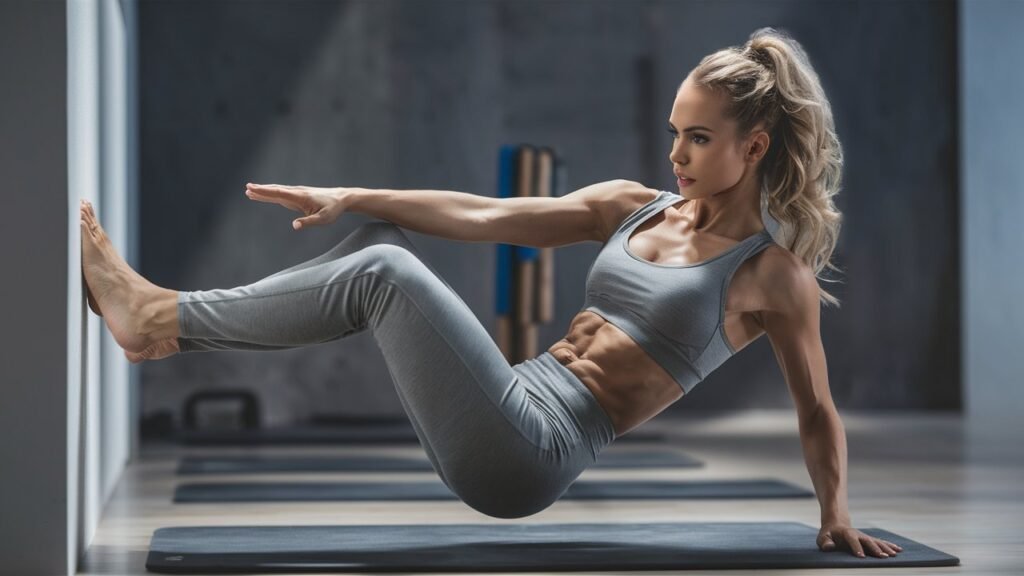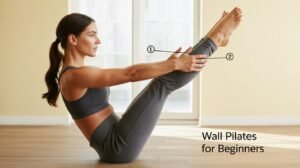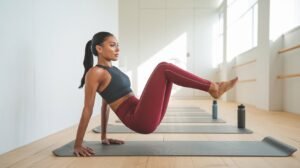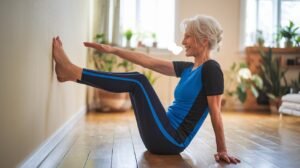Yoga and Pilates are often seen as complementary practices, each offering unique benefits that enhance overall well-being. For Yoga Practitioners with Wall Pilates, incorporating Wall Pilates into their routine can provide targeted strength and stability training, deepening their practice and improving their performance in various poses. This blog explores how Wall Pilates can be a transformative addition to your yoga journey.
What is Wall Pilates?
Wall Pilates combines traditional Pilates exercises with the stability and support of a wall. This approach allows for a greater focus on alignment, muscle engagement, and controlled movements. By leveraging the wall, practitioners can safely explore deeper stretches, improve balance, and strengthen key muscle groups that are essential for yoga.

How Wall Pilates Enhances Your Yoga Practice
1. Strengthening Core and Stabilizing Muscles
Core strength is fundamental in both Pilates and yoga. A strong core not only supports advanced yoga poses but also promotes better posture and overall stability. Wall Pilates exercises like the Wall Plank and Wall Roll Down engage deep abdominal muscles, helping yoga practitioners build a solid core foundation. This enhanced core strength translates to improved stability in challenging yoga poses such as handstands or arm balances.
2. Improving Flexibility and Range of Motion
Flexibility is a cornerstone of yoga practice, and Wall Pilates can significantly contribute to it. Using the wall for support, practitioners can safely push their limits and explore deeper stretches. Exercises such as the Wall Hamstring Stretch or Wall Shoulder Opener allow for gradual and controlled extension, increasing flexibility in muscles and joints crucial for yoga.
3. Enhancing Alignment and Posture
Proper alignment is essential in yoga to maximize the benefits of each pose and prevent injuries. Wall Pilates emphasizes correct body alignment and helps practitioners become more aware of their posture. Exercises like the Wall Bridge or Wall Squat promote an understanding of how to maintain alignment and balance, which can be directly applied to standing or balancing yoga poses.
4. Building Balance and Coordination
Balance is a key aspect of many yoga poses. Wall Pilates exercises challenge and enhance proprioception—the body’s ability to sense its position and movement. By practicing balance-centric movements such as the Wall Single-Leg Stance or Wall Warrior III, yoga practitioners can develop better control and coordination, leading to more stable and confident execution of balance poses like Tree Pose or Eagle Pose.
5. Supporting Safe and Progressive Practice
Wall Pilates offers a safe way to progress in your yoga practice. The wall provides a stable base for experimenting with more advanced poses or deepening stretches without risking injury. This safety net allows practitioners to explore their boundaries and gradually increase their capabilities in a controlled manner.
Integrating Wall Pilates into Your Yoga Routine
Incorporating Wall Pilates into your yoga practice can be simple and rewarding. Here’s how you can get started:
- Start with an Assessment: Identify areas in your yoga practice that could benefit from additional strength, flexibility, or balance training. A Pilates instructor can help tailor a program that complements your yoga routine.
- Regular Practice: Aim to include Wall Pilates sessions 2-3 times a week. Consistency is key to building strength and flexibility over time.
- Focus on Complementary Movements: Choose Wall Pilates exercises that support and enhance your yoga practice. For example, if you’re working on improving your backbends, focus on exercises that open the shoulders and strengthen the core.
- Monitor Progress: Keep track of your improvements in both Pilates and yoga. Notice how enhanced strength and stability from Wall Pilates translate into more control and depth in your yoga poses.

Sample Wall Pilates Exercises for Yoga Practitioners
1. Wall Plank
- Target: Core, Shoulders
- How to Do It: Place your hands on the wall at shoulder height and walk your feet back until your body forms a straight line. Engage your core and hold the position, maintaining a strong, aligned posture. This exercise builds strength for poses like Plank or Chaturanga Dandasana.
2. Wall Hamstring Stretch
- Target: Hamstrings, Lower Back
- How to Do It: Lie on your back with your legs up against the wall. Slowly lower one leg down while keeping the other extended up the wall. Hold the stretch, then switch legs. This exercise helps in deepening forward bends and improving leg flexibility.
3. Wall Shoulder Opener
- Target: Shoulders, Upper Back
- How to Do It: Stand facing the wall with your arms extended overhead, pressing your hands against the wall. Gently lean forward to deepen the stretch in your shoulders and upper back. This stretch is great for preparing for poses like Downward Dog or Wheel Pose.
4. Wall Bridge
- Target: Glutes, Lower Back
- How to Do It: Lie on your back with your feet flat against the wall and your knees bent. Lift your hips towards the ceiling, engaging your glutes and core. This exercise strengthens the muscles needed for backbends and improves overall hip stability.
Conclusion
Wall Pilates offers yoga practitioners a powerful tool to enhance their practice through targeted strength, flexibility, and stability training. By integrating Wall Pilates exercises into your routine, you can deepen your yoga poses, improve your alignment, and build a stronger, more resilient body. Whether you’re a seasoned yogi or just starting your journey, Wall Pilates can help you explore new dimensions in your practice with confidence and grace. Embrace Wall Pilates and elevate your yoga experience to new heights!











